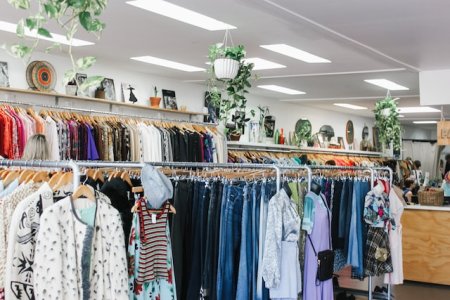What has happened to op shops? Have charity shops become greedy?
Charity shops (commonly known as op shops) used to be the choice for shoppers with tightened budgets. Others are simply looking for a bargain or trying to be more sustainable. But now, op shoppers are finding they’re no longer the soundest option, especially with rising costs that do not necessarily come with better items.
One op shopper took it to Reddit to vent. They said:
‘I was recently out and doing some browsing around the local op shops in the area and I was shocked by several things. First was the prices. Not going to name names, but I went to three of the "big name" op shops and a couple of local ones, and the prices on things were crazy. We are talking $30 for a pair of old jeans, t-shirts were all $10+, even the books were $10 for old paperbacks and kids' toys – they were asking $20 for a Thomas the tank engine plushie!
‘Seriously? For most of these things, you could get brand new for that price or not much more... I thought op shops were supposed to be a place for people facing financial issues to pick up some cheap donated products, not a second-hand up-market boutique store stocked by the charitable donations of the public.
‘And speaking of stock, every store I went to had the labels ripped off, not just the branding ones but the size tags too. I can only assume this is to prevent people buying "brand name" items and reselling them, but from what I could see, there were no "brand name items" there anyway.’
They also reminisced about the good old times: ‘I remember only a couple of years ago, going op shopping and coming away with a good size bag of clothes for the kids and myself that were good quality close to new looking. Now all that is on the floor seems to be close to being rags, and whatever was not was priced at ridiculous levels. Seriously, there were a couple of nice (though well-worn) dresses priced over $300! At an op shop!’
The Redditor shared the last straw: ‘The final cherry on top was that there was next to nothing in the ‘kids’ sections, the men's sections of all the stores consisted of a single rack and the majority of the stores’ floor space were dedicated to showcasing specialty women's wear or racks of women's clothing. Where are all the donations I see piled up in and around the bins going?’

Once considered a last resort, secondhand stores are seeing a boom in price-sensitive and eco-conscious customers. Credit: Unsplash
Other shoppers’ observations were not far off from the author’s. One said: ‘I’ve been op-shopping since the 1990s, and I’ve definitely noticed a change in pricing in the last few years. They’ve become terribly greedy and it’s rare to find a “good buy” now. Some things are more expensive than buying new!’
The commenter also noticed the shift in attitude regarding secondhand clothing. ‘It’s also a supply and demand thing. I think at the end of the 2000s and into the 2010s, with the hipster/retro boom, kitsch and vintage items increased in value (e.g. all things MCM) and op-shopping became a cool hobby or thing to do. My father told me that when he used to op-shop in the early 1980s, he was made to feel embarrassed by his middle-class peers, as it was considered the domain of poor people.’
Secondhand shopping is certainly becoming more appealing, and the numbers show that. The global ‘re-commerce’ market is expected to boom to 325 billion AUD in 2026, while already valued at 143 billion dollars in 2021.
Younger shoppers are also seemingly keener to buy pre-loved items than older generations. And while affordability remains the top reason for shoppers, others are motivated by their desire to curb the environmental effects of shopping for apparel. According to an eBay report, 34 per cent of consumers cited sustainability and reduced waste as reasons to shop secondhand.
It also doesn’t hurt pre-owned apparel shoppers are also seen as better dressers – a study found that people who rank higher on style consciousness are more likely to shop secondhand. The perception has somewhat changed, but the effects that came with it aren’t always desirable.
Another op-shopper chimed in: ‘op shops where you pay $5 for a leather jacket are few and far between. I miss finding cool bargains in op shops.’
A third said: ‘The standard of donations isn't what it used to be too, with much being cheap Kmart junk, to begin with. True quality items are rare, skimmed in sorting, or purchased quickly.’
A Redditor also commented: ‘The glory days are long behind us. Now, employees/volunteers are aware that many people buy just to flip for $$, so they price things higher accordingly.’
Someone who claimed to be working at Vinnies said it was the higher-ups responsible for the rising costs: ‘It's corporate that demands the prices go up. I can't stand it. They were selling a plastic toy car for $6!’
With inflation decreasing purchasing power, many Aussies are turning to thrift and secondhand stores for the first time. Shopping pre-loved has also become easier through online marketplaces. Platforms such as Gumtree, Facebook Marketplace, and eBay are all reporting a rise in secondhand listings and sales. But shopping for apparel can be tricky when you can’t try on items to determine fit, explaining the continuing appeal of op shops.
Recently, shoppers have called out op shops for their ‘ridiculous’ prices and charging ‘an arm and a leg for absolutely anything,’ however.
Like most businesses, charity op shops say they are struggling to strike a balance between good prices and revenue. Vinnies and Salvos refer to the price increase of goods for their pricing strategy, but they also have to cover operation costs and their charitable efforts.
Op shops maintain that they still are working to serve shoppers with different budgets. In an interview with The Guardian, Salvos’ General Manager for Customer and Strategy Edwina Morgan said: ‘Our prices are reflective of the Australian consumer market, and although perception is that inflation has had an impact on preloved or second-hand clothing prices broadly, we are continuing to focus on providing a diverse range of price points across our store network to cater to all types of needs and wants.’
So, what do you think, folks? Are you observing the same in your local op shops? How do you feel about the rising prices set by secondhand stores? Let us know in the comments!
One op shopper took it to Reddit to vent. They said:
‘I was recently out and doing some browsing around the local op shops in the area and I was shocked by several things. First was the prices. Not going to name names, but I went to three of the "big name" op shops and a couple of local ones, and the prices on things were crazy. We are talking $30 for a pair of old jeans, t-shirts were all $10+, even the books were $10 for old paperbacks and kids' toys – they were asking $20 for a Thomas the tank engine plushie!
‘Seriously? For most of these things, you could get brand new for that price or not much more... I thought op shops were supposed to be a place for people facing financial issues to pick up some cheap donated products, not a second-hand up-market boutique store stocked by the charitable donations of the public.
‘And speaking of stock, every store I went to had the labels ripped off, not just the branding ones but the size tags too. I can only assume this is to prevent people buying "brand name" items and reselling them, but from what I could see, there were no "brand name items" there anyway.’
They also reminisced about the good old times: ‘I remember only a couple of years ago, going op shopping and coming away with a good size bag of clothes for the kids and myself that were good quality close to new looking. Now all that is on the floor seems to be close to being rags, and whatever was not was priced at ridiculous levels. Seriously, there were a couple of nice (though well-worn) dresses priced over $300! At an op shop!’
The Redditor shared the last straw: ‘The final cherry on top was that there was next to nothing in the ‘kids’ sections, the men's sections of all the stores consisted of a single rack and the majority of the stores’ floor space were dedicated to showcasing specialty women's wear or racks of women's clothing. Where are all the donations I see piled up in and around the bins going?’

Once considered a last resort, secondhand stores are seeing a boom in price-sensitive and eco-conscious customers. Credit: Unsplash
Other shoppers’ observations were not far off from the author’s. One said: ‘I’ve been op-shopping since the 1990s, and I’ve definitely noticed a change in pricing in the last few years. They’ve become terribly greedy and it’s rare to find a “good buy” now. Some things are more expensive than buying new!’
The commenter also noticed the shift in attitude regarding secondhand clothing. ‘It’s also a supply and demand thing. I think at the end of the 2000s and into the 2010s, with the hipster/retro boom, kitsch and vintage items increased in value (e.g. all things MCM) and op-shopping became a cool hobby or thing to do. My father told me that when he used to op-shop in the early 1980s, he was made to feel embarrassed by his middle-class peers, as it was considered the domain of poor people.’
Secondhand shopping is certainly becoming more appealing, and the numbers show that. The global ‘re-commerce’ market is expected to boom to 325 billion AUD in 2026, while already valued at 143 billion dollars in 2021.
Younger shoppers are also seemingly keener to buy pre-loved items than older generations. And while affordability remains the top reason for shoppers, others are motivated by their desire to curb the environmental effects of shopping for apparel. According to an eBay report, 34 per cent of consumers cited sustainability and reduced waste as reasons to shop secondhand.
It also doesn’t hurt pre-owned apparel shoppers are also seen as better dressers – a study found that people who rank higher on style consciousness are more likely to shop secondhand. The perception has somewhat changed, but the effects that came with it aren’t always desirable.
Another op-shopper chimed in: ‘op shops where you pay $5 for a leather jacket are few and far between. I miss finding cool bargains in op shops.’
A third said: ‘The standard of donations isn't what it used to be too, with much being cheap Kmart junk, to begin with. True quality items are rare, skimmed in sorting, or purchased quickly.’
A Redditor also commented: ‘The glory days are long behind us. Now, employees/volunteers are aware that many people buy just to flip for $$, so they price things higher accordingly.’
Someone who claimed to be working at Vinnies said it was the higher-ups responsible for the rising costs: ‘It's corporate that demands the prices go up. I can't stand it. They were selling a plastic toy car for $6!’
With inflation decreasing purchasing power, many Aussies are turning to thrift and secondhand stores for the first time. Shopping pre-loved has also become easier through online marketplaces. Platforms such as Gumtree, Facebook Marketplace, and eBay are all reporting a rise in secondhand listings and sales. But shopping for apparel can be tricky when you can’t try on items to determine fit, explaining the continuing appeal of op shops.
Recently, shoppers have called out op shops for their ‘ridiculous’ prices and charging ‘an arm and a leg for absolutely anything,’ however.
Like most businesses, charity op shops say they are struggling to strike a balance between good prices and revenue. Vinnies and Salvos refer to the price increase of goods for their pricing strategy, but they also have to cover operation costs and their charitable efforts.
Op shops maintain that they still are working to serve shoppers with different budgets. In an interview with The Guardian, Salvos’ General Manager for Customer and Strategy Edwina Morgan said: ‘Our prices are reflective of the Australian consumer market, and although perception is that inflation has had an impact on preloved or second-hand clothing prices broadly, we are continuing to focus on providing a diverse range of price points across our store network to cater to all types of needs and wants.’
So, what do you think, folks? Are you observing the same in your local op shops? How do you feel about the rising prices set by secondhand stores? Let us know in the comments!








